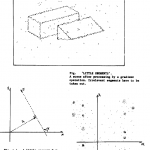Als ich gestern etwas mit OpenCV gearbeitet habe, bin ich auf eine
interesannte Seite gestossen [1] . Es wird dort von normailsierten RGB
geredet. Dabei wird getrennt für jeden Kanal, der Pixelwert durch die
Summe des Pixels über alle 3 Kanäle geteilt.
R’ = R/(R+G+B)
G’ = G/(R+G+B)
B’ = B/(R+G+B)
Dabei geht die Lichtinformation im Bild verloren. Ich finde das eine
interesannte Ausgangslage für weitere Berechnungen. Oft ist doch nur die
Farbe einzelner Objekte wichtig, nicht aber wie sie beleuchtet wurden.
Es sind nur noch 2 Byte pro Pixel, statt 3 Byte, notwenig.
R' + G' + B'=1
B' = 1 - R' - G'
Ein Angabe von 2 der 3 Werte ist also hinreichend. Damit kann der Farbort
charakterisiert werden, nicht aber die absolute Intensit¨t des Farbreizes. Das
heißt die Länge des Farbvektors wird nicht angegeben.
[1] http://www.aishack.in/tutorials/normalized-rgb/
